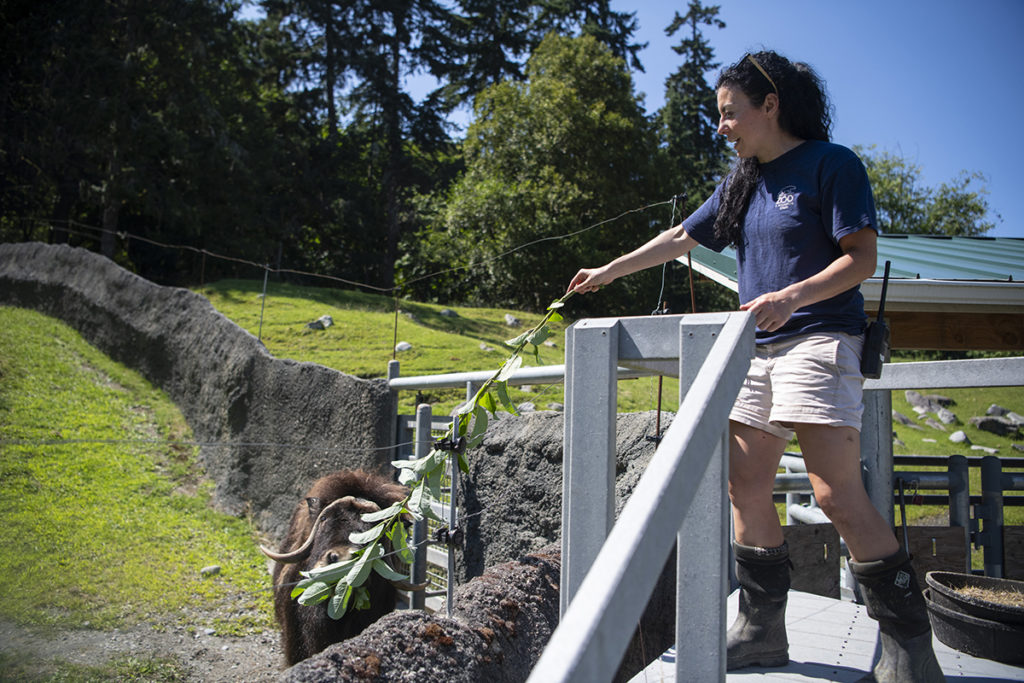What do you do if your 760-pound male muskox refuses to do what you ask him?
Well, if you’re a zookeeper, you have other strategies in your pocket. For keeper Piper, who cares for muskoxen, clouded leopards and an elephant at Point Defiance Zoo & Aquarium, it’s all in a day’s work.
7am
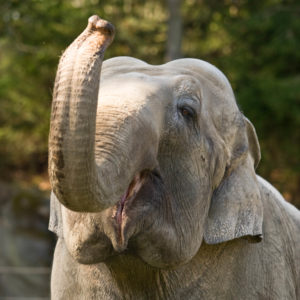
Piper’s day starts with her team, as staff meet to update each other on their various charges across the Zoo. The job covers a lot of ground, from the clouded leopard habitat in the Asian Forest Sanctuary, past Suki the elephant’s spacious digs and all the way across the Zoo to where muskoxen Charlotte and Hudson roam in Arctic Tundra. The team makes a plan for the day, and each keeper starts on their tasks.
7:30am
For Piper and fellow keeper Russell, that might begin with trunk training for Suki. At 56, Suki’s a super-senior elephant – which means maintaining strength and flexibility is really important. On the other hand, it also means she gets to choose exactly what exercise she does. Rewarded with fruit treats, she follows Piper and Russell’s cues for lifting her trunk up or out – a bit like lifting arm weights for a human.
“In the wild she’d be constantly foraging up high with her trunk, so it’s really important she keep up those muscles,” explains Piper. “It’s great to see her getting stronger over time.”
The two also tag-team to care for Suki’s feet, one giving her a pedicure (soaking, scrubbing, trimming toenails and cuticles) while the other gives fruit treats and watches the elderly elephant carefully to make sure she’s comfortable.
Finally, after another keeper has prepped Suki’s yard with fresh hay, she heads outside so Piper and Russell can clean her barn.
9am
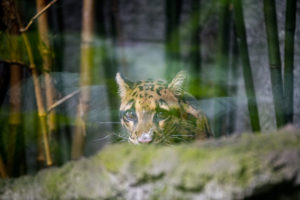
Piper heads to the clouded leopard area for morning duties. With five “cloudies” in residence (two more live at the Wild Wonders Outdoor Theater), there’s a lot to do. Today it’s Jao Ying’s turn in the public-facing habitat, so Piper makes the transition attractive by laying out a meat “scavenger hunt” for the leopard to find. She also arranges fresh bamboo branches to give extra hiding cover. (Rarely seen in their native Asian rainforests, clouded leopards are extremely shy.)
Finally, Piper adds a lovely big bone: “Chewing releases endorphins in cats, so this will make Jao Ying feel good the whole day,” she explains.
Then Piper checks on the other clouded leopards, cleaning their bedrooms and doing some training.
“We work on crate-training, so they can be comfortable if we need to give hand-injections for medical treatment,” Piper says. “We also practice the open-mouth behavior, which allows us to check their teeth regularly.”
10:30am
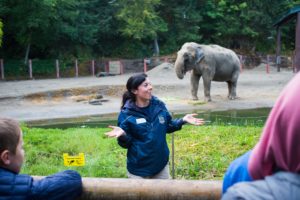
The team takes a mid-morning break, then Russell heads over to give an elephant Keeper Chat, offering Suki another chance to practice her trunk moves. If she chooses not to, that’s okay.
“We give our animals as much choice in their day as we can,” says Piper. “That improves their mental and physical well-being. And of course, she’s an 8,420-pound elephant. She gets to choose what she does.”
Meanwhile, Piper meets Zoo horticulturalist Bryon Jones to learn about harvesting techniques for cutting leafy browse (like bamboo) around the Zoo gardens.
She and Russell then head into the elephant barn to prepare more food enrichment for Suki: stuffing feeders high up with hay to help her forage and build more trunk and neck strength. (The feeders are special ones, made by Russell to hold the finely-mulched hay that Suki requires for her elderly-elephant teeth.) After she comes inside, they’ll set up more “food destinations” outside in her yard.
“It makes her day interesting and gives her more reasons to exercise,” explains Russell.
12pm
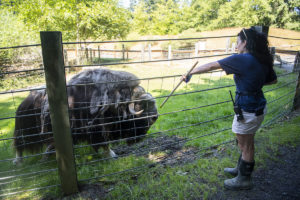
Finally, it’s lunchtime for the keepers. Then Piper and Russell head around to the muskoxen. Another keeper has already cleaned their yard and given them breakfast – an operation involving three-foot-deep containers with three kinds of grain – but now it’s time for a little Hudson training.
That’s if he’s willing, of course. Because right now, Hudson’s in rut – breeding time for male animals – and he’s really only thinking about one thing: his mate Charlotte.
“Hi, baby!” calls Piper, as she approaches the five-year-old muskox. “Let’s see if you’re interested in this.”
Standing safely in an enclosed habitat, Hudson grunts, and stares at Piper. She holds a yellow-painted pole over the fence, ready to reward the muskox with his favorite grain – Cheerios – if he touches the target with his nose. It’s a way of giving animals mental and physical stimulation, plus building a relationship with keepers.
Hudson’s having none of it. Lowering his head, he gives a deep “urggggggh” and starts pawing the ground.
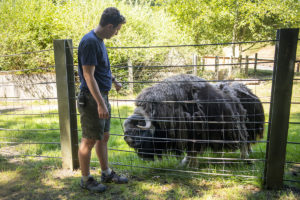
Piper laughs. “He’s showing me just how manly he is, making sure I’m not a rival for Charlotte,” she explains. “He’s not thinking with his whole brain at the moment. Let’s try something easier.”
Putting down the pole, she picks up some fresh willow branches, cut that morning by Russell.
“Hey, boy!” she calls. “Want some of this? It’s your favorite!”
Hudson stops pawing and sniffs, then ambles over to munch. Piper plants two muddy-booted feet for bracing – muskoxen are unbelievably strong.
“So, if I ask him for a behavior and he doesn’t do it – maybe he’s in rut and I’m competing with hormones – then I’m not going to keep on asking,” she explains. “That just reinforces the cue as meaningless for him. Instead, I’m going to ask something easier, that he wants to do.”
As a crowd of Zoo guests walk by, Piper keeps one eye on Hudson while introducing him and explaining what’s going on. She also shows them some freshly-shed quiviut (said “kee-vee-ut”), the super-soft undercoat that protects muskoxen from intense Arctic cold.
Then it’s time to give some love to Charlotte. Picking up more willow and a shovel, Piper and Russell walk around to the far side of the grassy habitat. Charlotte watches interestedly from behind the fence.
“Hey girl!” Piper calls, and climbs purpose-built stairs to hand a willow branch over to the female muskox. Then she spreads the rest inside the yard, setting some deliberately where Charlotte can get to them without Hudson interfering. While the pair have bred before, producing last year’s calf Trebek, Charlotte still needs to take breaks from the male attention.
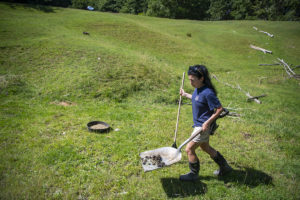
On her way back, Piper scoops up some poop, examining it carefully: If it’s glittery blue, it belongs to Charlotte.
“Tracking hormones in her poop is super-important so we can see if and when she gets pregnant,” explains Piper. “So to tell them apart, we add edible glitter to Charlotte’s food. It tends to get everywhere, though – and on sunny, dewy mornings, everything looks glittery.”
2:30pm
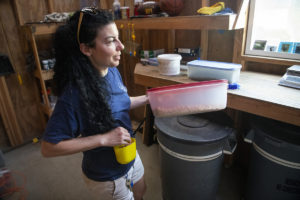
Piper heads back across the Zoo to give bones to the rest of the clouded leopards and giving them indoor-outdoor access for the night. Suki gets her afternoon medications, and access to more inside food and a water-hose if she chooses.
4:30pm
Piper and Russell make the day’s updates on the computer records for each animal, and at 5:30pm it’s time to go home – a ten-hour day, four-day week for their summer schedule.
Piper’s favorite part of the job?
“Definitely Hudson,” she says instantly. “I know you shouldn’t have favorites, but I helped raise him from a calf, and I have this bond with him. He’s got such personality!”
And the biggest challenge?
“It gets very emotional,” she explains. “You take it all home with you. In another job, maybe, you could just walk away and not care. But here, you care – you care for animals, and your team. And that’s what makes it so amazing as well.”
